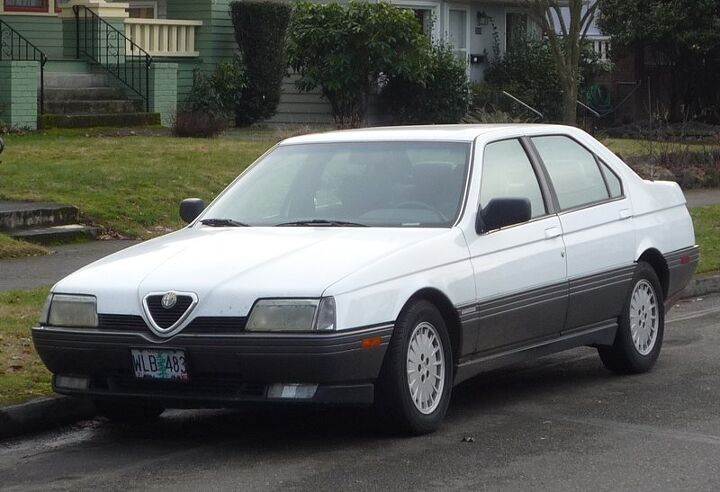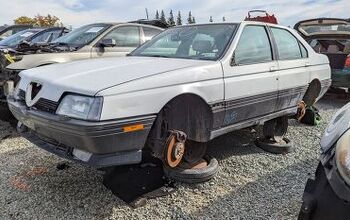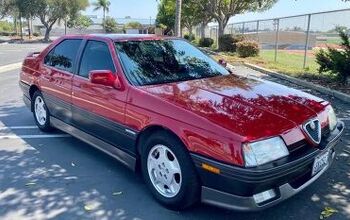Curbside Classic: 1991 Alfa Romeo 164

(Curbside Classics paid a quick visit to TTAC Command Central in Portland on Saturday, and came away with a few goodies to share from that CC Elysian Fields this week)
With the presumed return of Alfa to our shores, its easy to forget that it seems like just yesterday (to us oldsters) that Alfa was selling its handsome 164 sedan hereabouts until 1995. To the more youthful here, the 164 may have been something you ogled from the back of the family Caravan on the way to grade school. Regardless; it’s a quickly disappearing part of the street-scape, and has some fascinating history behind that tasty exterior.
The 164 was the last new car developed by an independent Alfa Romeo before they were bought by Fiat. But that doesn’t mean Fiat wasn’t already a major player in the 164’s genesis by another means: the 164 was one of four cars developed on the joint “Type 4” platform, which included the Fiat Croma, the Lancia Thema, and the Saab 9000. Even a grade schooler could see that the Fiat, Lancia and Saab were the chummy trio of the foursome. The doors from a Croma will install right on the Saab; etc. Obviously, the Alfa got special treatment; up to a point.
While the 164 certainly benefited from the distinctive styling from the other three, courtesy of Pininfarina, it failed to make sure there was an exclusivity clause in its contract with the storied design house. The 164 and the concurrently Pinin designed Peugeot 605 show a remarkable degree of familial similarity, perhaps even more so when they’re not right together like in this picture.
The 164 was a serious effort to move Alfa upscale, which had failed badly in its previous efforts to expand beyond its roots as sporty brand. Its prior effort, the Alfa 6, was about as successful in the larger sedan category as Fiat’s interesting but also unsuccessful 130. The Italians have never been able to crack the stranglehold of the German bigger sedans, even on their home turf. The “type 4” platform cars were to be the big breakthrough.
I don’t have all the sales stats and contemporary reviews in front of me, but my recollection is that the Croma and Thema may have been, at best, only marginally successful for Fiat in holding off BMW, Audi and Mercedes’ inroads further. The Thema 8.32 was a wild variant, featuring a Ferrari -sourced V8 mounted transversely, and a very high-grade interior; an Italian version of the Taurus SHO (not the interior part, that is).
I’m getting off topic again, as usual. The 164 and the Saab 9000 were probably the most successful of the four; the Saab’s fairly strong presence in the US being a major contributor. The 164 was taken quite seriously in Europe as a competitor in the executive saloon sector, and enjoyed a degree of success, both critically and commercially, that was unprecedented for a larger Alfa, at least since the days of the 2600 in the fifties and sixties.
In Europe, the 164 came with a variety of engines; the twin-spark 2.0 fours, both normally aspirated and turbo; a small-bore 2.0 turbo V6 (primarily for markets with a heavy displacement tax); a 2.5 diesel; and the beautiful 3.0 V6 which solely powered the US versions: a 12 valve version until ’93; then a 24 valver until the end. The power ratings were pretty healthy for the times too: from 183 hp (12 valve) to 230 hp for the 24 valve S version. The 3.0 was a sweet sounding and fine running motor, and went a long way to dispel any lingering doubts about a FWD Alfa, at least in a sedan.
I can’t claim any seat time in one of these cars, but maybe some of you can add your experiences. And although the 164 doesn’t (or does it?) have “Italian Reliability Nightmare” written all over it, it may still be included in the fine print. Any 164 sob stories out there?

More by Paul Niedermeyer
Latest Car Reviews
Read moreLatest Product Reviews
Read moreRecent Comments
- Schen72 2022 Toyota Sienna, 25k miles[list][*]new 12V battery, covered by warranty[/*][*]new tires @ 24k miles[/*][*]oil change every 10k miles[/*][*]tire rotation every 5k miles[/*][/list]2022 Tesla Model Y, 16k miles[list][*]nothing, still on original tires[/*][/list]
- Kjhkjlhkjhkljh kljhjkhjklhkjh Elon hates bad press (hence TWITTER circus) So the press jumping up and down screaming ''musk fails cheap EV'' is likely ego-driving this response as per normal ..not to side with tesla or musk but canceling the 25k EV was a good move, selling a EV for barely above cost is a terrible idea in a market where it seems EV saturation is hitting peak
- 1995 SC Wife has a new Ridgeline and it came with 2 years so I don't have to think about it for a while.My FIAT needed a battery (the 12V...not the drive battery), a replacement steering column cover and I had to buy a Tesla Charging adapter to use the destination charger at one of the places I frequent. Also had to replace the charge cable because I am an idiot and ran the stock one over and destroyed the connector. Around 600 bucks all in there but 250 is because of the cable.The Thunderbird has needed much the past year. ABS Pump - 300. Master Cylinder 100. Tool to bleed ABS 350 (Welcome to pre OBD2 electronics), Amp for Stereo -250, Motor mounts 150, Injectors 300, Airbag Module - 15 at the u pull it, Belts and hoses, 100 - Plugs and wires 100, Trans fluid, filter and replacement pan, 150, ignition lock cylinder and rekey - 125, Cassette Player mechanism - 15 bucks at the U Pull it, and a ton of time to do things like replace the grease in the power seat motots (it was hard and the seats wouldn't move when cold), Rear pinion seal - 15 buckjs, Fix a million broken tabs in the dash surround, recap the ride control module and all. My wife would say more, but my Math has me around 2 grand. Still needs an exhaust manifold gasket and the drivers side window acts up from time to time. I do it all but if I were paying someone that would be rough. It's 30 this year though so I roll with it. You'll have times like these running old junk.
- 3-On-The-Tree Besides for the sake of emissions I don’t understand why the OEM’s went with small displacement twin turbo engines in heavy trucks. Like you guys stated above there really isn’t a MPG advantage. Plus that engine is under stress pulling that truck around then you hit it with turbos, more rpm’s , air, fuel, heat. My F-150 Ecoboost 3.5 went through one turbo replacement and the other was leaking. l’ll stick with my 2021 V8 Tundra.
- Syke What I'll never understand about economics reporting: $1.1 billion net income is a mark of failure? Anyone with half a brain recognizes that Tesla is slowly settling in to becoming just another EV manufacturer, now that the legacy manufacturers have gained a sense of reality and quit tripping over their own feet in converting their product lines. Who is stupid enough to believe that Tesla is going to remain 90% of the EV market for the next ten years?Or is it just cheap headlines to highlight another Tesla "problem"?








































Comments
Join the conversation
Want the truth about the 164? It was a great car. It is a great car. And it remains so underpriced, even if you have to fix a few things (I think of restoration as an opportunity to upgrade with higher performance parts). I had two at once, a 92 manual 3.0 L and a 93 auto 3.0 L, from about 1996 to now: the manual from about 70k to 120k, which I traded to a friend for a big favor, and the auto from about 110k to 150k, which is still my daily driver. We just drove this 18 year old car from Cleveland snow to Austin record heat, and it did fine, even with a MIA engine cooling fan. It has spent many winters in the snow and has no noticeable body rust. The Alfa is a sure footed car in heavy snow. Debunking Myths: It's not at all a quirky car -- it is actually very solid in all meanings of the word. The auto transmission better suits the car than the manual -- the torque steer is a problem on the manual, not the auto, and the auto has the shift-down program, which is a completely different experience from most coast-in-high-gear auto transmissions. It's hard to use the gear selector to downshift the auto on the run, but if you plant the accelerator, it will happily drop two gears and take off, and it is always easy to find the right gear exiting a sweeper, using the foot. My AC stepper motor still works fine. The leather seats can be amazing, or can just be ok. In either case, the leather is better than the velour. The car is not unreliable compared to others I have owned (fewer electrical problems than a Jaguar XJ6, cheaper than a 944, recently no more expensive than a Subaru). I think I have been stranded twice -- when I blew the rotor cap off while accelerating quickly uphill, and when I threw a water pump belt when the pump died. The instrument panel is completely intuitive and quick and easy to use, once you get used to it. The engine makes lovely sounds, but you will more likely appreciate how it feels at the pedal when the air is dense and cool. It doesn't take specialized knowledge to work on the Alfa -- many mechanics have contributed well to keeping mine going. The car eats brake pads faster than tires, but doesn't do either in excess. The driving positions are excellent -- really very good -- anyone who says otherwise is strangely proportioned or has not actually driven the car. Genuine weaknesses: It handles well, but is limited by body roll (FWD is not actually an issue, as it is lively in big sweepers and too heavy to squirt around corners). You want to upgrade the springs on any 164 if you want to hustle it around bends. It has mediocre mpg -- 16 and 25, on premium 93 octane. And it has terrible door locks in cold weather. One can upgrade the door handles so they don't break when frozen, but they are still prone to freezing. The clutch on the manual tended to heat up and stick in traffic on hot days. It has a great Cd, but the location of the license plate in the front is not aerodynamic, and the shapes of the side mirrors could be better. Hidden strengths: The interior has many artistic touches that most will take years to notice, such as the lighting and their switches, the seat heater buttons, and the cross sections of the headrests/arm rests. The 164 alfa triangle is one of their best ever. The car interior is spacious for its narrow exterior width, and it will haul quite a bit of weight and volume without complaint. The car only really complains when it is just started and taken on the road before warming up. The car is amazingly well composed at speeds above 70mph, and compared to my Legend coupe, XJ6, 260e, 280se 4.5, 380sl, 924, or 944, all of which were capable at speed, it would seem to be hands down the safest car at european high speeds, with the best highway dynamics. Many owners have noticed that putting a racing lucky charm alfa triangle just behind the front wheel well makes the side view look terrific. I don't really care how fast this car is -- a 12v has plenty of torque, and the feel of the car is more dependent on the quality of the air. Speaking of which, the ANSA sport exhaust is worth the price, and I put Porterfield pads over ATI rotors to upgrade an already excellent braking system. If you are really serious, swap the stock air box with a power stack, and you'll unleash a lot more power until the MAF sensor gets dirty and you have to replace it. I don't think this car could benefit from supercharging, since it is already a heavy car designed for high speed composure, not outright acceleration. It is just not the right chassis for 250+ lb-ft. As Jeremy Clarkson says, an Alfa is engineered to be about as good as a car can be (for a short time), and you should just accept that the 164 is a european executive highway burner, NOT a Ford Mustang V8 or a 911. It's not so much aimed to beat the 300e or 528i as it is meant to be its own car. BTW, even though it is a 20 year old design, it feels very modern -- not like a current design, but certainly years ahead of other late 80's/early 90's competitors, certainly on par with a recent A4 or S40. Apparently Maximas were also good in that era, and I do know firsthand that the 300zx 3.0 feels a lot like the Alfa 164 3.0. Of all the cars I've mentioned, I prefer the 164. It is the best reflection of who I am, though the Jag came close in stature, and the 4-cylinder Porsches were much more entertaining. As an Italian, I prefer the Pininfarina 2000 to the 164, just because it is open and raw, and the 164 does not shout its Italian-ness. I do prefer the 164 to the Alfa spider 2000 ... the 164 is so well thought out and well balanced, while the graduate spider is such an uneven beauty. Both are classic Alfas, but the 164 blends the heart and the mind.
Funny, I just bought a 164 and it happens to be the exact same one pictured in this article. Incidentally it is a 1993 model, not a 1991 as the title of the article mentions.